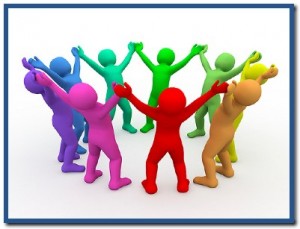 Cooperation is neither the province of women nor an artifact of maturity; cooperation fuels all peoples and emerges from our earliest days.
Cooperation is neither the province of women nor an artifact of maturity; cooperation fuels all peoples and emerges from our earliest days.
Kohlberg’s stages of moral development (1958) position obedience as preceding negotiation; thus, cooperation cannot emerge until the capacity for a certain amount of cognitive complexity has been achieved. While Gilligan’s In a Different Voice (1982) illuminated several deficiencies in Kohlberg’s vision, it did so on the basis of gender bias. According to Gilligan, “They [women] developed in a way that focused on connections among people (rather than separation) and with an ethic of care for those people (rather than an ethic of justice)” (Huff, 2001).
Designating empathy and cooperativeness as expressions of subgroups rather than universal human traits, though, is incredibly problematic. First, just who or what are men and women anyway? I wonder how, if at all, Gilligan’s paradigm accommodates for socially-constructed gender vs. biologically-tied sex. What happens when these superficial distinctions break down, as in the case of butch females, drag queens, transsexuals, intersex individuals, etc? Second, how do the historical record and contemporary social structures support this theory of opposing, partisan priorities? While I tend to distrust biological determinism, human evolution and culture, broadly defined, suggest that all peoples value collaboration and connection. Similarly (and sadly), abuse can induce individuals from all walks of life to commit atrocities that tear those institutions asunder.
Dacher Keltner’s Born to Be Good: The Science of a Meaningful Life (2009) argues that we are hard-wired to reach out and love someone:
“Jen science is based on its own microscopic observations of things not closely examined before. Most centrally, it is founded on the study of emotions such as compassion, gratitude, awe, embarrassment, and amusement, emotions that transpire between people, bringing the good in each other to completion. Jen science has examined new human languages under its microscope—movements of muscles in the face that signal devotion, patterns of touch that signal appreciation, playful tones of the voice that transform conflicts. It brings into focus new substances that we are made of, neurotransmitters as well as regions of our nervous system that promote trust, caring, devotion, forgiveness, and play. It reveals a new way of thinking about the evolution of human goodness, which requires revision of longstanding assumptions that we are solely wired to maximize desire, to compete, and to be vigilant to what is bad” (Keltner, 2009, para 3).
Along a similar vein, Richard Sennett’s Together: The Rituals, Pleasures and Politics of Cooperation (2012) conceptualizes cooperation as a homegrown, human craft. Excitingly, he draws on developmentalist Erik Erikson and children’s gaming to strengthen his argument:
“Reflexive, self-critical thinking doesn’t imply withdrawal from other kids; children can be reflexive together. One piece of evidence Erikson provides for this process is game-playing. At the age of five to six, children begin to negotiate the rules for games, rather than, as at the age of two to three, take the rules as givens; the more negotiation occurs, the more strongly do children become bonded to one another in game-playing…
“Erikson’s sweeping point about this passage is that cooperation precedes individuation: cooperation is the foundation of human development, in that we learn how to be together before we learn how to stand apart. Erikson may seem to declare the obvious: we could not develop as individuals in isolation. Which means, though, that the very misunderstandings, separations, transitional objects and self-criticism which appear in the course of development are tests of how to relate to other people rather than how to hibernate; if the social bond is primary, its terms change up to the time children enter formal schooling” (Sennett, 2012)
Our mission, therefore, is to support the skills and spaces that facilitate development of the ties that bind. I’ll stop short of calling for hand-holding and Kumbayah-singing — but if you start the song, you know I’ll chime right in.

